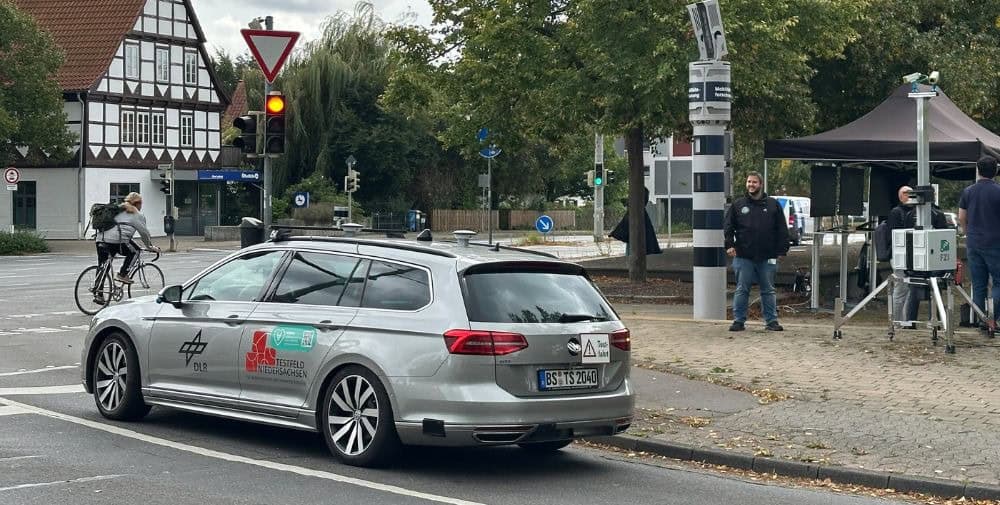
More safety and efficiency by using data from the local environment
In order to achieve an increase in traffic efficiency and safety in the future mixed traffic of urban traffic areas, the LUKAS research project uses all the information available in the local environment, for example from infrastructure sensors, networked cars and commercial vehicles, but also from mobile devices such as smartphones of pedestrians or cyclists. This concept provides anonymized data from road users and stationary objects. They include, for example, position, dimensions, driving speed if applicable, and direction of movement. The preprocessed sensor information is passed on to a so-called edge server, a server that is directly connected to the 5G network in the vicinity of the intersection and enables data transmission with minimal delay times.
A fusion algorithm of the edge server is able to create a comprehensive model of the local environment and plan maneuvers for networked road users based on it. Object information of the server environment model is fed back to it. This expands the overview to include areas that the road users themselves cannot cover. “The edge server uses artificial intelligence methods, among other things, to calculate an optimized, cooperative maneuver and transmits instructions for action to the networked road users.
LUKAS pilot facility in Ulm-Lehr
The testing took place in public spaces: For this purpose, the consortium used a pilot installation supported by the city of Ulm and operated by the University of Ulm in the Lehr district. This is an intersection with a turning priority road and a side road leading into it. Due to the buildings there, there is visual coverage of the priority road, which makes this road situation particularly interesting for real traffic. “This installation offers us excellent opportunities to test the approaches we have researched and developed directly in real traffic and thus to make a statement about their practical suitability very quickly,” explains Priv.-Doz. Dr.-Ing. Michael Buchholz, head of the Electromobility and Connected Driving/Networked Infrastructure research groups at the Institute of Measurement, Control and Microtechnology at Ulm University, who is responsible for the pilot system.
In the intersection area, the lampposts are equipped with video, lidar and radar sensors to detect and classify ongoing traffic. The object information – people and vehicles are not identifiable for data protection reasons – is sent to the Edge server via a 5G network from partner Nokia. This hosts the global environment model, various investigated variants of cooperative maneuver planning, and a warning module for pedestrians and cyclists.
Safer and more efficient on the road thanks to networking
To illustrate cooperative use cases in mixed traffic, Bosch, Mercedes-Benz, and the University of Ulm are bringing in networked and partially automated passenger cars. InMach will present a networked prototype sweeper. Special smartphone apps from IT-Designers GmbH and Nokia enable the networking of pedestrians and cyclists with the Edge server. For simulative support of traffic scenes, IT-Designers collects data with a video drone. The University of Duisburg-Essen supports the project with traffic flow simulations.
In all tested use cases, the benefits of the LUKAS approach in terms of increasing traffic efficiency and safety could be verified. Simulative results of AI-based planning algorithms suggest a significant increase in traffic flow. Studies by the partner Mercedes-Benz show a significant reduction in fuel consumption as well as a reduction in passing times in the intersection area compared to conventional driving. Passing stationary vehicles and crossing vulnerable road users are safeguarded in blind areas by delaying oncoming traffic for cooperative behavior. Thanks to the new technology and cooperative scene planning, road users recognize at an early stage which driving strategy will allow them to behave safely and efficiently.
With the results of the LUKAS project, the consortium partners were able to gather insightful experience regarding connected, cooperative driving and incorporate it into the development of new products. The approach developed by LUKAS can contribute to making automated driving in urban mixed traffic more efficient and safer for all road users.
– – – –
Further links
👉 www.bosch.de
Photo: Bosch




